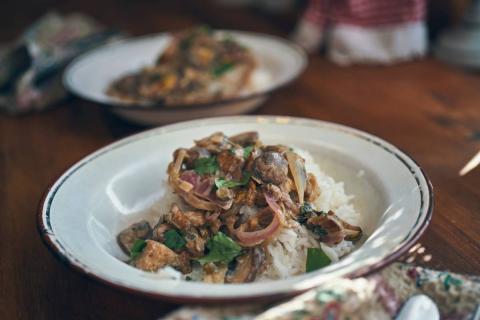Largely recognised as one of the finest, if not the finest French restaurant in Asia, Hong Kong’s Amber at the Mandarin Oriental is a must visit spot for any fine dining lover in the city. Consistently in the top five of Asia’s 50 Best Restaurants and currently number 24 on the World’s 50 Best Restaurants list, it has held two Michelin stars for nine consecutive years.

Picture above: Miyazaki wagyu beef, strip loin, barbecued with dulse & red cabbage slaw, oxalis, horseradish & pepper berry emulsion © Amber at The Landmark Mandarin Oriental, Hong Kong
At the helm is Dutch-born Executive Chef Richard Ekkebus, who arrived in Hong Kong in 2005 via the kitchens of esteemed French chefs, such as Pierre Gagnaire, Alain Passard and Guy Savoy. But Ekkebus has managed, with the classics as his base, to infuse his acclaimed, multi-course cuisine with Cantonese touches, such as the use of seaweed instead of salt in Amber’s signature dish of Hokkaido sea urchin in lobster Jell-O with caviar and cauliflower cream, which has been on the menu for over eight years (in the picture at the top of the article). “If you Google my name, probably the first picture you’ll see is a sea urchin,” jokes Ekkebus. See the recipe here.

Picture above: Dombes Frog Legs © Amber at The Landmark Mandarin Oriental, Hong Kong
During Amber’s pre-launch phase, ‘Western-style dim sum’ was muted as a style reveals Ekkebus, but he didn’t see it through, fearing the reaction. “The best French food in Hong Kong then was very traditional – we had to find a point of difference. We didn’t do the dim sum, but we did include elements of Cantonese influence – and some people hated it – we had blue fin tuna with a sesame seed emulsion with crispy chicken feet. People wondered what on earth we were serving. So we had to adapt, and tone things down. 12 years later, Maaemo in Oslo is serving crispy goose feet with cherry and oxalis and the dining public is ready to accept it.”

Picture above: Cleanser, Canapes & Mise en Bouches © Amber at The Landmark Mandarin Oriental, Hong Kong
Another classic Amber dish is the Foie gras Chupa Chups, which used to be served as an amuse bouche. Now, a meal at Amber starts with a selection of lighter bites, with an emphasis on the vegetal. “Many of the mains [feature] protein, so we wanted to take away the protein from the start of the meal. We get very excited to work with new ingredients each season.” Each amuse bouche represents a different, clearly defined taste profile: salt, sour, bitter, sweet, and umami.
Picture above: Foie Gras Chupa Chup with Beetroot & Raspberry © Amber at The Landmark Mandarin Oriental, Hong Kong
Ekkebus likes to add a hint of acidity to this dishes by using citrus, spice or vinegar, as in a more recent dish of Abalone with vinegar and black pepper-seasoned tomatoes, crispy oxtail and oxtail jus, a dish which the chef says “is on the verge of becoming iconic.”

Picture above: Korean abalone, black pepper & vinegar seasoned tomato compote, braised then crisped oxtail & its jus © Amber at The Landmark Mandarin Oriental, Hong Kong
Technology also plays a role: “We’re not a molecular restaurant but [technology] has a tremendous affect on how we cook. We’ve found cleverer ways of doing things and traditions are being broken all the time. We have been rooted in traditions of French cuisine, but [at the same time,] we have been very receptive and sensitive of new ideas. It’s important not to bury our heads in rules that were set in French kitchens”.
Picture above: Heirloom carrots, confit with & orange blossom honey, carrot cake, segments, zest & sorbet of blood orange © Amber at The Landmark Mandarin Oriental, Hong Kong
Picture above: Kacinkoa 85% chocolata, ganache, fisherman’s friend dust, peppermint & white chocolate sorbet © Amber at The Landmark Mandarin Oriental, Hong Kong
Picture above: Shimaebi prawn tail raw, marinated with citrus & beetroot, crispy fried head with calamansi emulsion © Amber at The Landmark Mandarin Oriental, Hong Kong








